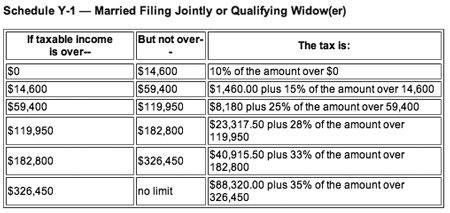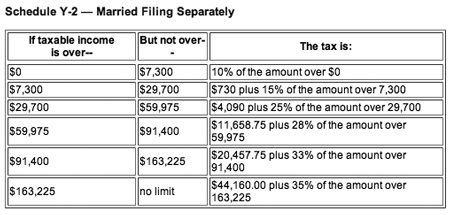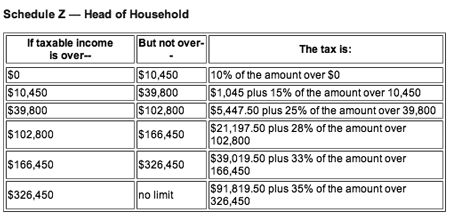TAX LAW CHANGES FOR INDIVIDUALS • TAX YEAR 2005
Charitable
contributions
Definition of a child
Earned Income Credit
Electric and clean-fuel vehicles
Empowerment zone stock
Exemption amounts
Retirement savings plans
Social security & Medicare taxes
Standard deduction
Standard mileage rates
Tax rate schedules - 2005

Charitable
Contributions of Vehicles, Boats, and Aircraft
If
you donate a vehicle (including a boat or aircraft) to
a qualified organization after December 31, 2004, your deduction is
limited to the gross proceeds from its sale by the organization. This
rule applies if the claimed value of the donated vehicle is more than
$500. However, you generally can deduct its fair market value if the
organization:
- Makes
significant intervening use of the vehicle,
- Materially
improves the vehicle, or
- Transfers
the vehicle to a needy individual in direct furtherance of the donee's
charitable purpose
of relieving the poor and distressed or underprivileged who are in
need of a means of transportation.
Boats, aircraft, and other vehicles.
These
rules apply to donations of boats, aircraft, and any vehicle manufactured
mainly for use on public streets, roads, and highways.
Acknowledgement required.
If
the claimed value of the car is more than $500, you must have a written
acknowledgement of your donation from the organization and must attach
it to your return. If you do not have an acknowledgement, you cannot
deduct your contribution.
The
acknowledgement must include the following information:
- Your
name and taxpayer identification number.
- The
vehicle identification number or similar number.
- A
statement certifying the car was sold in an arm's
length transaction between unrelated parties.
- The
gross proceeds from the sale.
- A
statement that your deduction may not be more than the gross proceeds
from the sale.
- The
date of the contribution.
However,
if there was significant intervening use of or material improvement
to the car by the organization, the acknowledgement does not have to
include the information in items 3, 4, and 5 above. Instead, it must
contain a certification of the intended use of or material improvement
to the car and the intended duration of that use and a certification
that the vehicle will not be transferred in exchange for money, other
property, or services before completion of that use or improvement.
This
acknowledgement must be provided within 30 days of the sale of the car
or, if there is significant intervening use or material improvement
of the car by the organization, within 30 days of the contribution.
The
organization also must provide this information to the IRS.
Donations of inventory.
These
rules do not apply to donations of inventory. For example, these rules
do not apply if you are a car dealer who donates a car you had been
holding for sale to customers.
More information.
More
information can be found in Notice 2005-44 and the 2005 revision
of Publication 526, Charitable Contributions (to be available mid-December
2005).
Uniform Definition of a Qualifying Child
Beginning
in 2005, one definition of a ?qualifying childÇ will apply for
each of the following tax benefits.
- Dependency
exemption.
- Head
of household filing status.
- Earned
income credit (EIC).
- Child
tax credit.
- Credit
for child and dependent care expenses.
Tests To Meet
In
general, all four of the following tests must be met to claim someone
as a qualifying child.
Relationship test.
The
child must be your child (including an adopted child, stepchild, or
eligible foster child), brother, sister, stepbrother, stepsister, or
a descendent of one of these relatives.
An
adopted child includes a child lawfully placed with you for legal adoption
even if the adoption is not final.
An
eligible foster child is any child who is placed with you by an authorized
placement agency or by judgement, decree, or other order of any court
of competent jurisdiction.
Residency test.
A
child must live with you for more than half of the year. Temporary absences
for special circumstances, such as for school, vacation, medical care,
military service, or detention in a juvenile facility count as time
lived at home. A child who was born or died during the year is considered
to have lived with you for the entire year if your home was the child's
home for the entire time he or she was alive during the year. Also,
exceptions apply, in certain cases, for children of divorced or separated
parents and parents of kidnapped children.
Age test.
A
child must be under a certain age (depending on the tax benefit) to
be your qualifying child.
Dependency exemption, head of household filing status, and EIC.
For
purposes of these tax benefits, a child must be under the age of 19
at the end of the year, or under age 24 at the end of 2005 if a student,
or any age if permanently and totally disabled.
A
student is any child who, during any 5 months of the year:
- Was
enrolled as a full-time student at a school, or
- Took
a full-time, on-farm training course given by a school or a state,
county, or local government agency.
A
school includes a technical, trade, or mechanical school. It does not
include an on-the-job training course, correspondence school, or night
school.
Child tax credit.
For
purposes of the child tax credit, a child must be under the age of 17.
Credit for child and dependent care expenses.
For
purposes of the credit for child and dependent care expenses, a child
must be under the age of 13 or any age if permanently and totally disabled.
Support test.
A
child cannot have provided over half of his or her own support during
the year.
Exception.
For
purposes of the EIC only, the Support test does not apply.
Qualifying Child of More Than One Person
Sometimes
a child meets the tests to be a qualifying child of more than one person.
However, only one person can treat that child as a qualifying child.
If you and someone else (other than your spouse if filing jointly) have
the same qualifying child, you and the other person(s) can decide who
will claim the child. If you cannot agree on who will claim the child
and more than one person files a return using the same child, the IRS
may disallow one or more of the claims using the tie-breaker rule explained
in Table 1.
Table
1. When More Than One Person Files a Return Claiming the Same Qualifying
Child (Tie-Breaker Rule)

Dependency Exemption
To
claim the dependency exemption for a qualifying child, all four tests
listed earlier under Tests To Meet must be met. The child generally
must also be a U.S. citizen, U.S. national, or a resident of the United
States, Canada, or Mexico. An exception applies for certain adopted
children. If married, he or she cannot file a joint return unless the
return is filed only as a claim for refund and no tax liability would
exist for either spouse if they had filed separate returns.
A
person who used to qualify as your dependent but who is not your "qualifying
child" may still qualify as your dependent as a "qualifying
relative." To claim the dependency exemption for a qualifying relative,
the child cannot be the qualifying child of any other person and all
five dependency tests discussed under Dependency Tests in Publication
501 must be met.
Note:
If you are a dependent of another person, you cannot claim any dependents
on your return.
Head of Household Filing Status
In
general, you can use head of household filing status only if, as of
the end of the year, you were unmarried or "considered unmarried"
and you paid over half the cost of keeping up a home:
- That
was the main home for all the entire year of your
parent whom you can claim as a dependent (your parent did not have
to live with you), or
- In
which you lived for more than half of the year with either of the
following:
A. Your qualifying child (defined earlier, but without regard to
the exception for children of divorced or separated parents).
But, if your qualifying child is married at the end of the year,
see Married child below.
B. Any
other person whom you can claim as a dependent.
But
you cannot use head of household filing status for a person who is your
dependent only because:
- He
or she lived with you for the entire year, or
- You
are entitled to claim him or her as a dependent under a multiple support
agreement.
Married child.
If
your qualifying child is married at the end of the year, both of the
following must apply for the child to be your qualifying child for purposes
of head of household filing status.
- The
child cannot file a joint return unless the return is filed only as
a claim for refund and no tax liability would exist for either spouse
if they had filed separate returns.
- The
child must be a U.S. citizen, U.S. national, or a resident of the
United States, Canada, or Mexico. An exception applies for certain
adopted children.
Earned Income Credit (EIC)
You
may be able to claim the earned income credit (EIC) in 2005 if you have:
- 2
or more qualifying children and your earned income is less than $35,263
($37,263 if married filing jointly for 2005),
- 1
qualifying child and your earned income is less than $31,030 ($33,030
if married filing jointly for 2005), or
- No
qualifying children and your earned income is less than $11,750 ($13,750
if married filing jointly for 2005). For purposes of the EIC, a qualifying
child must meet the Relationship test, Residency test (without regard
to the exception for children of divorced or separated parents), and
Age test, earlier. A qualifying child does not have to meet the Support
test for purposes of the EIC. But, if your qualifying child is married
at the end of the year, see Married child next.
Married child.
A
child who is married at the end of the year is a qualifying child for
purposes of the EIC only if you can claim him or her as your dependent
(see Dependency Exemption, earlier) or this child's other parent claims
him or her as a dependent under the rules for children of divorced or
separated parents in Publication 501, Exemptions, Standard Deduction,
and Filing Information.
Child Tax Credit
You
may be able to take the child tax credit if you have a qualifying child
that meets all four of the tests listed earlier under Tests To Meet.
For additional rules that you must meet, see Publication 972, Child
Tax Credit.
Credit for Child and Dependent Care Expenses
Generally,
a qualifying person for purposes of the credit for child and dependent
care expenses is:
- Your
qualifying child (defined earlier, but without regard to the exception
for parents of kidnapped children), or
- Your
dependent or spouse who is physically or mentally incapable of caring
for himself or herself and who lived with you for more than half of
the year.
For
purposes of the credit for child and dependent care expenses, a qualifying
child and dependent are determined without regard to the exception for
children of divorced or separated parents and the child is treated as
a qualifying person only for the custodial parent.
For
additional rules that you must meet, see Publication 503, Child and
Dependent Care Expenses. However, you no longer need to meet the Keeping
Up a Home test discussed in Publication 503.

EARNED INCOME CREDIT AMOUNTS INCREASE
Earned
income amount.
The
maximum amount of income you can earn and still get the credit is higher
for 2005 than it is for 2004. You may be able to take the credit for
2005 if:
- You
have more than one qualifying child and you earn less than $35,263
($37,263 if married filing jointly),
- You
have one qualifying child and you earn less than $31,030 ($33,030
if married filing jointly), or
- You
do not have a qualifying child and you earn less than $11,750 ($13,750
if married filing jointly).
The
maximum amount of adjusted gross income (AGI) you can have and still
get the credit has also increased. You may be able to take the credit
if your AGI is less than the amount in the above list that applies to
you.
Investment income amount.
The
maximum amount of investment income you can have in 2005 and still get
the credit increases to $2,700.
Electric and Clean Fuel Vehicles
For
2005, the proposed 50% reduction of the maximum electric vehicle credit
and the clean-fuel deduction has been eliminated. You can claim the
maximum electric vehicle credit allowed for a qualified electric vehicle
you place in service in 2005.
You
can claim the maximum deduction allowed for qualified clean-fuel vehicle
or other clean-fuel property placed in service in 2005.

Section 1202 Exclusion Increased for Gain from Empowerment Zone Business
Stock
You
generally can exclude up to 50% of your gain on the sale or trade of
qualified small business stock held by you for more than 5 years. This
is called the section 1202 exclusion. Beginning in 2005, you generally
can exclude up to 60% of your gain if you meet the following additional
requirements.
- You
sell or trade stock in a corporation that qualifies as an empowerment
zone business during substantially all of the time you held the stock.
- You
acquired the stock after December 21, 2000.
Condition
(1) will still be met if the corporation ceased to qualify after the
5-year period that begins on the date you acquired the stock. However,
the gain that qualifies for the 60% exclusion cannot be more than the
gain you would have had if you had sold the stock on the date the corporation
ceased to qualify.
The
part of the gain that is included in income is a 28% rate gain. See
Capital Gain Tax Rates and Section 1202 Exclusion in chapter 4 of Publication
550, Investment Income and Expenses.
For
more information about empowerment zone businesses, see Publication
954, Tax Incentives for Distressed Communities.
Exemption Amount Increased
The
amount you can deduct for each exemption has increased from $3,100 in
2004 to $3,200 in 2005.
You
lose all or part of the benefit of your exemptions if your adjusted
gross income is above a certain amount. The amount at which the phaseout
begins depends on your filing status.
For
2005, the phaseout begins at:
- $109,475
for married persons filing separately,
- $145,950
for single individuals,
- $182,450
for heads of household, and
- $218,950
for married persons filing jointly or qualifying widow(er)s.
If
your adjusted gross income is above the amount for your filing status,
use the Deduction for Exemptions Worksheet in the Form 1040 instructions
to figure the amount you can deduct for exemptions.
Retirement Savings Plans
Traditional
IRA income limits. If you have a traditional individual retirement account
(IRA) and are covered by a retirement plan at work, the amount of income
you can have and not be affected by the deduction phaseout increases.
The amounts vary depending on filing status.
Limit
on elective deferrals. The maximum amount of elective deferrals under
a salary reduction agreement that can be contributed to a qualified
plan increases to $14,000 ($18,000 if you are age 50 or over). However,
for a SIMPLE plan, the amount increases to $10,000 ($12,000 if you are
age 50 or over).
IRA
deduction expanded. The amount you, and your spouse if filing jointly,
may be able to deduct as an IRA contribution will increase to $4,000
($4,500 if age 50 or older at the end of 2005).
Social Security and Medicare Taxes
For
2005, the employer and employee will continue to pay:
- 6.2%
each for social security tax (old-age, survivors, and disability insurance),
and
- 1.45%
each for Medicare tax (hospital insurance).
Wage
limits. For social security tax, the maximum amount of 2005 wages subject
to the tax is $90,000. For Medicare tax, all covered 2005 wages are
subject to the tax.
Standard Deduction Amount Increased
The
standard deduction for taxpayers who do not itemize deductions on Schedule
A of Form 1040 is, in most cases, higher for 2005 than it was for 2004.
The amount depends on your filing status, whether you are 65 or older
or blind, and whether an exemption can be claimed for you by another
taxpayer.
The
basic standard deduction amounts for 2005 are:
- Head
of household ‹ $7,300
- Married
taxpayers filing jointly and qualifying widow(er)s
‹ $10,000
- Married
taxpayers filing separately ‹ $5,000
- Single
‹ $5,000
The
standard deduction amount for an individual who may be claimed as a
dependent by another taxpayer may not exceed the greater of $800 or
the sum of $250 and the individual's earned income.
Standard Mileage Rates
For
tax years beginning in 2005, the allowable deductions for the standard
mileage rate for the period January 1, 2005, through August 31, 2005,
are as follows:
- Business
miles. The standard mileage rate for the cost of operating your car
increases to 40.5 cents a mile for all business miles driven.
- Charitable
services. The standard mileage rate allowed for use of your car when
you use your car to provide charitable services to a charitable organization
is 14 cents a mile.
- Charitable
services ‹ Hurricane Katrina relief services. If you used your
vehicle in giving services to a charitable organization to provide
relief related to Hurricane Katrina, the standard mileage rate
allowed for use of your car is 29 cents a mile for miles driven after
August 24, 2005, and before September 1, 2005.
- Medical
reasons. The standard mileage rate allowed for use of your car for
medical reasons is 15 cents a mile.
- Moving.
The standard mileage rate for determining moving expenses is 15 cents
a mile.
The
allowable deductions for the standard mileage rate for the period September
1, 2005, through December 31, 2005, are as follows:
- Business
miles. The standard mileage rate for the cost of operating your car
increases to 48.5 cents a mile for all business miles driven.
- Charitable
services. The standard mileage rate allowed for use of your car when
you use your car to provide charitable services to a charitable organization
remains at 14 cents a mile.
- Charitable
services. Hurricane Katrina relief services. If you used your vehicle in
giving services to a charitable organization to provide relief related
to Hurricane Katrina, the standard mileage rate allowed for use
of your car is 34 cents a mile.
- Medical
reasons. The standard mileage rate allowed for use of your car for
medical reasons is 22 cents a mile.
- Moving.
The standard mileage rate for determining moving expenses is 22 cents
a mile.
2005 Tax Rate Schedules
Note:
These tax rate schedules are provided so that you can compute your estimated
tax for 2005. To compute your actual income tax, please see the instructions
for 2005 Form 1040, 1040A, or 1040EZ as appropriate when they are available.




© 2015 TLC Magazine Online, Inc. |